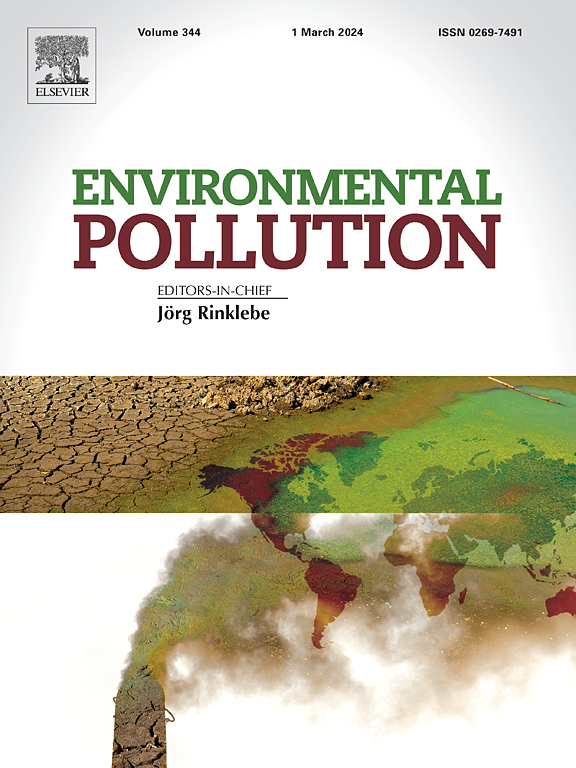A Systematic Approach to Mitigate Ozone Pollution in Northern Taiwan: Evidence from De-pollutant Analysis
IF 7.6
2区 环境科学与生态学
Q1 ENVIRONMENTAL SCIENCES
引用次数: 0
Abstract
Strict air pollution control regulations in Taiwan have led to a gradual decrease in PM2.5 and most gaseous pollutants from 2012 to 2022, except for ozone (O3). With annual average concentrations frequently surpassing the Taiwan Ambient Air Quality Standards (AAQS) of 60 ppb (95th percentile of daily maximum 8-hour averages), O3 remains a major air quality concern in northern Taiwan. The present study applied machine learning (ML) models, including positive matrix factorization-eXtreme Gradient Boost-SHapely Additive Explanation (PMF-XGB-SHAP), on three years of hourly data to investigate the influence of meteorological parameters, emission sources and other pollutants on O3 formation at an urban site in Taipei. Then, novel de-pollutant models were developed by controlling the anthropogenic emission factors in the model to quantify the impact of reduction on ambient O3 levels, and de-weather was applied to assess the impact of meteorological parameters. Findings showed that meteorology contributed 46.7–54.8% and 44.9–54.0% to daytime and nighttime O3 levels, respectively, with relative humidity (RH) and boundary layer height (BLH) as dominant influencing factor. Among pollutants, NOX displayed a consistent negative association, while PM2.5 showed a positive relationship with daytime O3 levels. The association between vehicular VOCs and O3 varied across years, reflecting changes in traffic patterns. Furthermore, de-pollutant analysis demonstrated that simultaneous 50% reductions in CO, SO2, and VOCs from industrial emissions could lower O3 concentrations by 13.4–22.6% during pollution episode days. By providing a quantitative, source-specific pathway for precursor control, the de-pollutant modelling approach establishes a framework for air quality management in other regions grappling with complex, multi-source ozone pollution.

减轻台湾北部臭氧污染的系统方法:来自去污染物分析的证据
台湾严格的空气污染控制法规导致PM2.5和大多数气态污染物从2012年到2022年逐渐减少,除了臭氧(O3)。由于年平均浓度经常超过台湾环境空气质量标准(AAQS) 60 ppb(每日最大8小时平均值的第95百分位),O3仍然是台湾北部主要的空气质量问题。本研究运用机器学习(ML)模型,包括正矩阵分解-极端梯度增强-形状加性解释(PMF-XGB-SHAP),对台北市某城市3年每小时数据进行分析,探讨气象参数、排放源和其他污染物对O3形成的影响。然后,通过控制模型中的人为排放因子,建立新的去污染模型,量化减少对环境O3水平的影响,并应用de-weather来评估气象参数的影响。结果表明:气象对白天和夜间O3水平的贡献率分别为46.7% - 54.8%和44.9% - 54.0%,其中相对湿度(RH)和边界层高度(BLH)是主要影响因子;在污染物中,NOX与白天O3水平呈一致的负相关关系,PM2.5与白天O3水平呈正相关关系。车辆VOCs和O3之间的关系在不同年份有所不同,反映了交通模式的变化。此外,去污染物分析表明,在污染发生的日子里,工业排放的CO、SO2和VOCs同时减少50%,可以使O3浓度降低13.4-22.6%。通过为前体控制提供定量的、特定来源的途径,去污染物建模方法为其他地区应对复杂的、多源臭氧污染的空气质量管理建立了一个框架。
本文章由计算机程序翻译,如有差异,请以英文原文为准。
求助全文
约1分钟内获得全文
求助全文
来源期刊

Environmental Pollution
环境科学-环境科学
CiteScore
16.00
自引率
6.70%
发文量
2082
审稿时长
2.9 months
期刊介绍:
Environmental Pollution is an international peer-reviewed journal that publishes high-quality research papers and review articles covering all aspects of environmental pollution and its impacts on ecosystems and human health.
Subject areas include, but are not limited to:
• Sources and occurrences of pollutants that are clearly defined and measured in environmental compartments, food and food-related items, and human bodies;
• Interlinks between contaminant exposure and biological, ecological, and human health effects, including those of climate change;
• Contaminants of emerging concerns (including but not limited to antibiotic resistant microorganisms or genes, microplastics/nanoplastics, electronic wastes, light, and noise) and/or their biological, ecological, or human health effects;
• Laboratory and field studies on the remediation/mitigation of environmental pollution via new techniques and with clear links to biological, ecological, or human health effects;
• Modeling of pollution processes, patterns, or trends that is of clear environmental and/or human health interest;
• New techniques that measure and examine environmental occurrences, transport, behavior, and effects of pollutants within the environment or the laboratory, provided that they can be clearly used to address problems within regional or global environmental compartments.
 求助内容:
求助内容: 应助结果提醒方式:
应助结果提醒方式:


